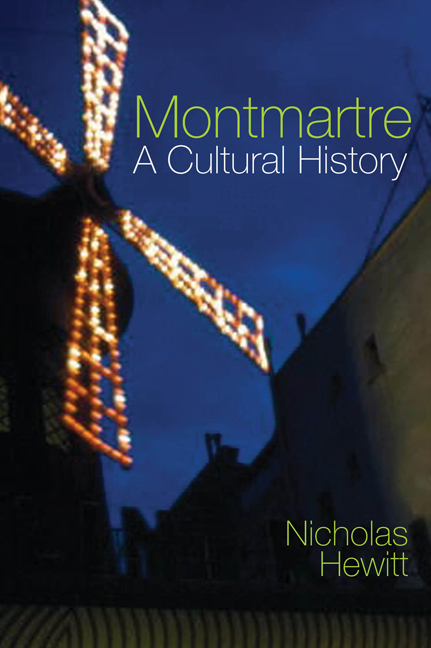Book contents
- Frontmatter
- Dedication
- Contents
- List of Illustrations
- Acknowledgements
- Map
- Introduction
- 1 ‘Montons à la Barrière’
- 2 The Artistic Cabarets
- 3 Music Halls and Mass Culture
- 4 Theatre and the Avant-Garde
- 5 The Bateau-Lavoir and the Lapin Agile
- 6 Wartime and the Années Folles
- 7 The Place of Memory
- 8 The Ecole de Montmartre
- 9 The Occupation: Céline and Aymé
- Epilogue: Montmartre on Film
- Bibliography
- Index
- Plate section
Introduction
- Frontmatter
- Dedication
- Contents
- List of Illustrations
- Acknowledgements
- Map
- Introduction
- 1 ‘Montons à la Barrière’
- 2 The Artistic Cabarets
- 3 Music Halls and Mass Culture
- 4 Theatre and the Avant-Garde
- 5 The Bateau-Lavoir and the Lapin Agile
- 6 Wartime and the Années Folles
- 7 The Place of Memory
- 8 The Ecole de Montmartre
- 9 The Occupation: Céline and Aymé
- Epilogue: Montmartre on Film
- Bibliography
- Index
- Plate section
Summary
The Legend of Utrillo
On 5 November 1955, Maurice Utrillo, one of the iconic and unexpectedly longest-surviving figures of Montmartre bohemia, died of lung disease at the age of seventy-two in the five-star Hôtel Splendid in the south-western spa town of Dax. With his death, an important period in the cultural history of Paris, beginning in the early years of the Third Republic, came to an end. The illegitimate son of Suzanne Valadon, Utrillo was born in 1883 and brought up in the bohemian world of the Butte de Montmartre in the Golden Period before the First World War, a world characterised by the artists of the older generation like Renoir, Degas and Lautrec, with their successors among the Fauves and Cubists, and also by a rapidly evolving popular and commercial culture in Bas-Montmartre. Within this close community on the Butte, of which the cabaret Le Lapin Agile was one of the major centres, Utrillo rapidly carved out a unique and equivocal reputation, despite his early antipathy to painting and his ambition to be a writer. On the one hand, as his early biographer Francis Carco records, the Utrillo of the ‘White Periode’, who mixed plaster of Paris and cement into his palate, richly merited the description of ‘un grand peintre’. In a major retrospective exhibition on twentieth-century French art at the Royal Academy in London, his Impasse Cottin, of 1910–11, depicting a Montmartre staircase rising up to the top of the Butte, was by no means out of place next to Picasso's ethereal cubist Sacré-Coeur of the same year. At the same time, in and out of psychiatric hospitals for most of his life and often imprisoned in his own room on the Butte, his madness and alcoholism came to epitomise the dark side of bohemia, its misères along with its splendeurs. In his sensitive appraisal of Utrillo's importance as a painter, Carco also records his degradation:
On était sûr de le rencontrer là, debout, près du comptoir, ou, quand il avait bu, dehors, devant la porte, couché dans le ruisseau et hurlant quelquefois qu'il était le diable. Moi qui l'ai vu, rue Saint-Vincent, serrer contre son coeur une bouteille vide, la caresser avec amour, puis tout à coup la fracasser, il me faisait pitié. On ne voulait de lui nulle part.
- Type
- Chapter
- Information
- MontmartreA Cultural History, pp. 1 - 14Publisher: Liverpool University PressPrint publication year: 2017



